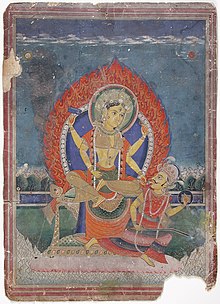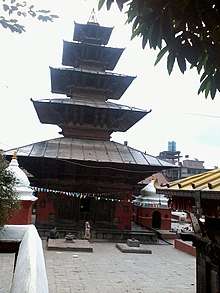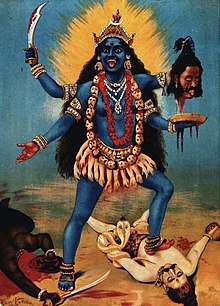Bagalamukhi
"Baglamukhi" or "Bagala" (Devnagari: बगलामुखी) is one of the mahavidyas (great wisdom/science), a group of ten Tantrik deities in Hinduism. Devi Bagalamukhi smashes the devotee's misconceptions and delusions (or the devotee's enemies) with her cudgel. The word "Bagala" is derived from the word "Valga" (meaning – bridle or to rein in) which, became "Vagla" and then "Bagla".[1] The Devi has 108 different names (some others also call her by 1108[2] names). Bagalamukhi is commonly known as Pitambari Maa in North India, the goddess associated with yellow color or golden color. She rides on Bagula bird, which is associated with Concentration, a pearl of great wisdom.
| Bagalamukhi (Peetambara) | |
|---|---|
Suspension (one who can bring a foe's physical and mental actions to a standstill).
The Goddess Who Paralyzes enemies. | |
| Member of The Ten Mahavidyas | |
 | |
| Affiliation | Devi, Mahavidya, Adishakti, Parvati, Sati, Shivasakthi |
| Abode | Haridra Sarovar (Turmeric Ocean) |
| Mantra | ॐ ह्लीं बगलामुखी सर्व दुष्टानां वाचं मुखं पदं स्तम्भय जिव्हां कीलय बुद्धिं विनाशय ह्लीं ॐ स्वाहा ॥ [Om Hleem Bagala-mukhi sarva dushtanam vacham mukham padam stambhay jeevhwam keelaye buddhim vinashaya hleem om swaha] |
| Weapon | Cudgel |
| Mount | Bagula or sarus crane |
| Consort | Shiva as Bagalamukha |
Bagalamukhi is one of the ten forms of the wise Devi, symbolizing potent female primeval force.
The main temples dedicated to Bagalamukhi or Bagala Devi are located at Kamakhya Temple, Guwahati, Assam and Kangra, Himachal Pradesh.
Iconography
Another interpretation translates her name as "Kalyani".In Kubjika Tantra there is a reference to yet another interpretation of the meaning of the name ‘Bagala’. In the initial chapter of the text, there is a verse – ‘Bakare Baruni Devi Gakare Siddhida Smrita. Lakare Prithivi Chaiba Chaitanya Prakrirtita’ (‘Ba’, the first letter of the name – ‘Bagala’, means ‘Baruni’ or ‘She Who is filled with the intoxicating mood to vanquish the demon’. ‘Ga’, the second letter, means ‘She Who grants all kinds of divine powers or siddhis and successes to human beings’. ‘La’, the third letter, means ‘She Who is the foundation of all kinds of sustaining powers in the world like the earth and is Consciousness Herself’.[3]
Two descriptions of the goddess are found in various texts: the Dwi-Bhuja (two-handed), and the Chaturbhuja (four-handed). The Dwi-Bhuja depiction is the more common and is described as the "Soumya" or milder form. She holds a club in her right hand with which she beats a demon, while pulling his tongue out with her left hand. This image is sometimes interpreted as an exhibition of stambhana, the power to stun or paralyse an enemy into silence. This is one of the boons for which Bagalamukhi's devotees worship her. Other Mahavidya goddesses are also said to represent similar powers useful for defeating enemies, to be invoked by their worshippers through various rituals.
Bagalamukhi is also called Pitambaradevi, Shatrubuddhivinashini and Brahmastra Roopini and she turns each thing into its opposite.
The Tantrasara describes her iconography: Bagalamukhi sits in a golden throne in the midst of an ocean in an altar. Her complexion is yellow (golden). Clad in yellow clothes, she is adorned by a garland of yellow flowers and decked with yellow (golden) ornaments. She pulls the tongue of a demon by her left hand, while raising the right hand to strike him with a club.[4] Another description says that she has four arms and a third eye. A yellow crescent moon adorns her forehead.[4]
Though generally depicted with a human head, the goddess is sometimes described to have a head of a crane and sometimes depicted ridding a crane. Sometimes, she is described associated with other birds: having a duck-head or a nose of a parrot.[5]
Etymology and other epithets

Kinsley translates Bagalamukhi as "she who has the face of a crane". Bagalamukhi is rarely depicted with a crane-head or with cranes. Kinsley believes that the crane's behaviour of standing still to catch prey is reflective of the occult powers bestowed by the goddess.[5]
Another interpretation suggests that Baglamukhi is a corruption of the word Valgamukhi; valga means "bridle" or "bit". Like the bridle or bit – placed in the mouth – is used to direct a horse, Bagalamukhi gives the supernatural power of control over one's foes.[5] In this context, Bagalamukhi is she "whose face has the power to control or conquer".[6]
Another etymology suggests that valga means "to paralyze" and symbolizes the power of stambhana, "paralysis" that the goddess is said to grant; this theory seems questionable to Kinsley.[7]
Bagalamukhi is known by the popular epithet Pitambara-devi or Pitambari, "she who wears yellow clothes". The iconography and worship rituals repeatedly refer to the yellow colour.[8]
Legend
In the Satya Yuga (the first epoch in Hindu cosmology), a great storm started destroying Creation. The god Vishnu was disturbed and performed austerities to appease the goddess Sati on shore of Haridra Sarovar, the lake of turmeric. Pleased with Vishnu, the goddess appeared and brought forth her manifestation Bagalamukhi from the lake. Bagalamukhi calmed the storm, restoring order in the universe.[9]
Another tale records that a demon named Madan[10] acquired Vak-siddhi, by which whatever he said came true. He misused it to trouble humans and murder people. The gods beseeched Bagalamukhi. The goddess grabbed the demon's tongue and immobilized his power. Madan requested the goddess that he be worshipped with her; the goddess granted him this boon, before slaying him.[11]
Symbolism and associations
Bagalamukhi is strongly associated with the yellow colour. She dresses in yellow clothes and ornaments. Various texts describe her affinity to the colour; yellow is an integral part of her worship rituals. Bagalamukhi is propitiated with yellow offerings by devotees dressed in yellow, seated on a yellow cloth. Yellow turmeric bead rosary are used in her japa (repetition) of her names or mantra (invocation). The colour yellow is linked to the Sun, gold, the earth, grain and fire, signifying auspiciousness, bountifulness and purity. The yellow turmeric is associated with marriage.,[8] that's why goddes Bagalamukhi also known as Pitambhara devi.[12]
Bagalamukhi is praised as the giver of supernatural powers (siddhis) or magical powers (riddhis).[13]
In ‘Bagalamukhistotratram’, a part of ‘Rudrayamala’ (a famous Tantra work), there are hymns in praise of the powers of Goddess Bagalamukhi – “Vadi Mukati Rankati Kshitipatirvaishwanarah Sheetati Krodhi Samyati Durjanah Sujanati Khsipranugah Khanjati. Garvi Khanjati Sarvaviccha Jarati Tvanmantrinaamantritah Srinitye Baglamukhi Pratidinam Tubhyam Namah “(By the effect of Your Mantra good conversationalists become speechless; rich become beggars; devastating fire gets cooled. The anger of the angry person is removed; an evil minded person becomes good. The quick moving person becomes crippled. The conceit of the conceited person is reduced. Knowledgeable person nearly becomes a fool. Salutations to the compassionate Bagalamukhi!)[14][15]
Worship

[16] Kamakhya Temple in Guwahati is considered to be the center of Tantricism, where there is the presence of temples dedicated to the ten Mahavidyas. A few hundred metres away from the Kamakhya Temple is the temple dedicated to the Goddess Bagalamukhi. Major temples to the goddess are situated in the Pathankot Mandi highway NH20 at Kotla and Bankhandi Himachal Pradesh in the north, and at village badowan near mahilapur disst Hoshiarpur Punjab India and at Nalkheda at Agar Malwa district in Madhya Pradesh and Pitambara Peeth in Datia and DusMahavidhya Temple at Nikhildham Bhojpur -Bhopal Madhya Pradesh. In South India there is a temple at Bagalapeetam, Eraiyur Road, Vallakottai in Kanchipuram district in Tamil Nadu. Sree suryamangalam, Kallidaikurichi, Papankulam village in Tirunelveli district in Tamil Nadu.[17]
In Somalapura (Kalyani) of Sindhanur taluk, Raichur district of North Karnataka there is a less known but very powerful Bagulamukhi Sidhdha Peeth ( A Sidhdha peetha is a temple built by a great yogi after Devi's sakshaatkara and falling to the love of the yogi, devi promises to preside in the temple )or temple is there built by great yogi Shri Chidanandavadhoota around 300 years ago. 'Shree Devi Charitre' was composed by Chidanandavadhoota which is read in every household of Karnataka even today. Her prayers pacify Brihaspati.
In Virupaskhi, a small village next to Mulabagil of Kolar district Karnataka, there is a Bagulamukhi temple. The Bagulamukhi temple is part of temple complex of Virupakshi temple. The mythology tells that the Virupaskha ling was installed by great sage Atri Maharshi, father of Shriguru Dattatreya. The linga changes its color in 3 ways from sunrise to sunset. It is believed that King Vikramaditya built the Bagulamukhi temple at Virupakshi.
Nepal, where the worship of tantric goddesses had Royal patronage, also has a large temple devoted to Bagalamukhi in the Newar city of Patan in Nepal near Kathmandu. The territory of the Bagalamukhi temple in Patan also has several other temples dedicated to Ganesha, Shiva, Saraswati, Guheswar, Bhairava, etc.
References
- "About Bagalamukhi". Retrieved 5 September 2016.
- "1108 Names of Bagalamukhi Ma". Retrieved 5 September 2016.
- Pravrajika Vedantaprana, Saptahik Bartaman, Volume 28, Issue 23, Bartaman Private Ltd., 6, JBS Haldane Avenue, 700 105 (ed. 10 October 2015) p.19
- Kinsley (1997), p. 193
- Kinsley (1997), pp. 196–7
- Frawley p. 130
- Kinsley (1997), pp. 197–8
- Kinsley (1997), pp. 198–9
- Kinsley (1997), pp. 193–4
- "Bagalamukhi | Mahavidya". Retrieved 2019-07-20.
- Kinsley (1997) pp. 194–5
- Kirti Kalra. "बगलामुखी माँ और यन्त्र". newstrend.news (in Hindi). Retrieved 9 May 2020.
- Kinsley (1997), p. 198
- Pravrajika Vedantaprana, Saptahik Bartaman, Volume 28, Issue 23, Bartaman Private Ltd., 6, JBS Haldane Avenue, 700 105 (ed. 10 October 2015) p.20</
- Benimadhav Sil’s Phool Panjika, 31, Abhinash Kairaj Street, Kolakta – 700 005. (ed. 2014–2015) p. 255
- "Baglamukhi Mantra". Baba Vishwanath Ji. Retrieved 2019-07-12.
- "Archived copy". Archived from the original on 2014-12-21. Retrieved 2014-12-21.CS1 maint: archived copy as title (link)
Bibliography
| Wikimedia Commons has media related to Bagalamukhi. |
- Frawley, David (1994). Tantric Yoga and the Wisdom Goddesses: Spiritual Secrets of Ayurveda. Lotus Press. ISBN 978-0-910261-39-5.
- Kinsley, David R. (1988). "Tara, Chinnamasta and the Mahavidyas". Hindu Goddesses: Visions of the Divine Feminine in the Hindu Religious Tradition (1 ed.). University of California Press. ISBN 978-0-520-06339-6.
- Kinsley, David R. (1997). Tantric Visions of the Divine Feminine: The Ten Mahāvidyās. University of California Press. ISBN 978-0-520-20499-7.
- S Shankaranarayanan (2002) [1972]. The Ten Great Cosmic Powers. Samata Books. ISBN 81-85208-38-7.

